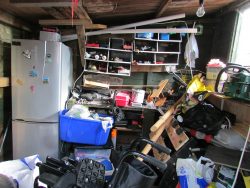Compulsive Hoarding
Compulsive hoarding, often referred to as pathological collecting, is the inability to discard insignificant and/or useless objects. This condition can interfere with daily functioning, cause financial issues and/or lead to unhealthy relationships. Compulsive hoarding can occur in various degrees, but when it is clinically significant, it can severely limit the amount of space in the home. This condition can restrict daily activities such as: cleaning, sleeping, cooking and/or movement around the house. This can be especially dangerous if the collection of objects restricts access to safe locations within the home. If doors and/or windows are filled with trash, debris and other items it may be impossible or difficult to reach safety outside of the home in case of a fire or other emergency. Compulsive hoarding may also lead to a variety of health problems due to improper sanitation.
It is still undetermined whether or not compulsive hoarding should be classified as an isolated disorder or linked with other conditions such as obsessive compulsive disorder. Research suggests that compulsive hoarding can be an individual disorder or a symptom of another condition. Approximately 5% of adults display some degree of hoarding behaviors. Adults are more likely to develop this disorder then children and adolescents.
Factors That Are Associated With Compulsive Hoarding Include:
- Excessive Alcohol Consumption
- Psychosis or Paranoia
- Obsessive Compulsive Behaviors
- Schizophrenia
- Avoidant Personality Traits
Diagnosis
Diagnosis requirements for compulsive hoarding disorder include:

Over-cluttering and making a space unlivable is a symptom of compulsive hoarding.
- Difficulty discarding items or parting with possessions regardless of their value.
- Difficulty is felt due to very strong urges to hold on to items and distress is felt when discarding them.
- Accumulation of a huge number or possessions that fill living space and make the area no longer accessible or livable. (The hoarding disorder can cause you to create a space which is deemed harmful to yourself and/or harmful to others due to the over-cluttering of objects).
- Symptoms must cause severe distress and impairment in occupational, social and other areas of functioning.
- Symptoms are not due to another general medical condition
- Symptoms are not restricted to other mental disorders like OCD, major depressive disorder, schizophrenia or any other psychotic disorder.
Warning Signs
In its worst forms, compulsive hoarding can result in fire emergencies, improper sanitation within the home and unhealthy living conditions, which may result in cockroach and rat infestations, various safety hazards and the risks of tripping over objects and getting hurt.
Warning Signs That You May Be a Compulsive Hoarder:
- You amass a large amount of objects and items that majority of the people would deem worthless or useless. (These may include: junk mail, old newspapers and magazines, clothes, trash, broken or torn items, objects that can be used in crafting and/or freebies from different places).
- Your house is “overly cluttered” and space for performing normal, daily activities is restricted. Some portions of your house may become so inaccessible that they cannot be used for storage or other purposes. (This may include beds that cannot be slept on, kitchens that are not fit for cooking, refrigerators that are too full with rotten food to store anything else, stovetops that are occupied with old, rotting piles of food and other useless items, tables that cannot be used for the purpose of dining, sofas and other seating furniture that cannot be sat on, unsanitary conditions in the bathrooms that force you and others to use other parts of the house for defecation and/or large amounts of sick, injured or dead animals residing in the home.
- The clutter and the unsanitary conditions lead to the development of various infection, viruses and/or diseases, impairment as well as distress. You are afraid to invite friends, family, guests and/or professionals over to the house to help clean because you are too ashamed to let anyone she the clutter you have accumulated. You may keep the inside of the house concealed by drawing shades or shutting the windows to block the view. You may also experience frequent arguments and disagreements with friends and members of your family regarding themassive clutter. Your risk of disease, fire emergencies and/or rodent and insect infestations is heightened when you are a compulsive hoarder. It is not uncommon for you to feel depressed, hopeless and helpless due to the mounting clutter in the home.
Treatment
Psychopharmacological interventions and cognitive behavioral therapy have shown to be ineffective when treating compulsive hoarding. Alternative treatment methods have shown some promise when treating this disorder.
Alternative Treatment Approaches for Compulsive Hoarding:
- Try to figure out why you feel so compelled to hoard (amass) objects and items (with the help of a trained mental health professional).
- Learn how to organize your possessions and decide what is important to you and what you can live without (when it comes right down to it).
- Strengthen your decision-making skills (with the help of a therapist).
- Hire a professional organizer to “de-clutter” your home.
- Learn relaxation skills.
- Attend family therapy or group therapy, if possible.
- Check yourself into an inpatient treatment program or hospital for intensive treatment.
References:
Pertusa, A., Fullana, M. A., Singh,S., Alonso, P., Menchón, J.M.,& Mataix-Cols D. (2008). Compulsive hoarding: OCD symptom, distinct clinical syndrome, or both? American Journal of Psychiatry. Retrieved from www.ncbi.nlm.nih.gov/pubmed/18483134
American Psychiatric Association. (2012). DSM-5 development: Hoarding disorder. Retrieved from www.dsm5.org/ProposedRevisions/Pages/proposedrevision.aspx?rid=398
Clinical Trials. (2008). Treatment of compulsive hoarding. Retrieved from clinicaltrials.gov/ct2/show/NCT00073346
Bubrick, J., Neziroglu, F., Yaryura-Tobias, J. (2004). Overcoming compulsive hoarding: Why you save you and how you can stop. Retrieved from http://books.google.com/books?id=xs7hAAAACAAJ&dq=Overcoming+Compulsive+Hoarding:+Why+You+Save+and+How+You+Can+Stop&source=bl&ots=D_7cQzcEVq&sig=-GwVycP-ZZVqUrqEikn8CYYs-Pc&hl=en&sa=X&ei=-39WUI2MA4q-9QSsj4CwCQ&ved=0CDYQ6AEwAA





